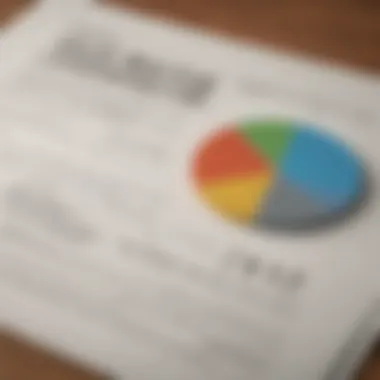Removing Old Items from Your Credit Report Effectively


Intro
A clean credit report can feel like the golden ticket to better financing options, lower interest rates, and overall peace of mind. But what happens when your credit report is cluttered with old items that no longer reflect your financial behavior? Learning how to remove these outdated entries isn't just a task; it’s a pathway to financial health. This article will guide you through effective strategies to eliminate old items, ensuring your credit profile stays fresh and accurate.
Understanding the significance of what’s on your credit report is key. Each line item tells a story about how you handle credit. Old debts or inaccuracies can cast a long shadow over your credit score. The darker that shadow, the less appealing you appear to lenders. In this exploration, we will dissect the step-by-step process for disputing these items and maintaining a robust credit profile through ongoing vigilance and informed practices.
In a world where financial decisions hinge on credit scores, addressing the less favorable elements of your report could be a pivotal step toward financial empowerment.
Understanding Credit Reports
Understanding credit reports is crucial for anyone looking to maintain a solid financial foundation. These documents hold a wealth of information about one's credit behavior, influencing everything from loan approvals to interest rates. As old items on a credit report can weigh heavily on your score, grasping the ins and outs of these reports not only equips you with the knowledge to remove outdated entries but also prepares you to make informed financial decisions that align with your goals.
What is a Credit Report?
A credit report is a detailed account of an individual’s credit history. It reflects how responsible a person has been in managing credit obligations. Typically compiled by credit bureaus, like Experian, Equifax, and TransUnion, these documents include personal information, credit accounts, payment history, and public records.
Understanding what goes into a credit report is vital, as errors or old, negative items can linger and detrimentally affect your credit score, sometimes for years. With time, however, individuals can learn to navigate these reports and mitigate the impact of less favorable information.
Key Components of a Credit Report
To simplify, let’s break down the key components of a credit report. Each part plays a significant role, either illuminating your creditworthiness or revealing areas that may need urgent attention. Here's what you need to know:
Credit Accounts
Credit accounts are like the lifeblood of your credit report. These refer to any active or inactive credit lines, including revolving accounts such as credit cards and installment loans like mortgages or car loans. Each account is recorded with important details that help lenders assess your borrowing behavior.
One key characteristic to consider is the credit utilization ratio, which indicates how much credit you are currently using versus how much you have available. A low utilization ratio is typically beneficial, showcasing responsible credit management, while a high ratio can signal financial strain or over-reliance on credit, which may lead to concerns for potential lenders.
Payment History
Payment history is often touted as the most critical aspect of your credit report. It accounts for about 35% of your credit score. This section reflects whether you've paid your bills on time and includes any late payments, defaults, or delinquencies. A clean payment history signifies reliability and financial responsibility, making it a valuable asset in the eyes of lenders. On the flip side, a history marred by missed or late payments can hinder your ability to secure new credit, much like an anchor holding you back.
Inquiries
Inquiries refer to the requests made by lenders to check your credit report. There are two types of inquiries: hard pulls and soft pulls. Hard inquiries occur when you apply for credit and can temporarily dent your credit score. Soft inquiries, often conducted for pre-approval offers or by companies checking their own credits, don't impact your score.
The key characteristic here is how many hard inquiries you have. A lengthy list could raise red flags for lenders, indicating you might be in search of multiple loans simultaneously. Therefore, while inquiries aren't weighted heavily in your score, they act as a snapshot of your recent credit-seeking behavior, offering lenders insight into your current financial situation.
Understanding these components can empower individuals to take charge of their credit reports, recognizing which areas require attention when it comes to removing old or negative items. By actively managing each section, you can substantially improve your credit profile and set the stage for financial success.
The Impact of Old Items on Your Credit Score
When discussing credit reports, it's crucial to understand how old items can influence your credit score. The impact of aged data, whether beneficial or detrimental, is a central theme in this article. As investors, financial advisors, and other industry professionals know, every point of a credit score can be significant in securing loans or favorable interest rates. The presence of old accounts can also tell a story about a consumer's creditworthiness. Therefore, grappling with how these old items affect the score is not just about numbers; it is about understanding personal finance management.
How Old Accounts Affect Your Credit Score
Old accounts can act like double-edged swords in your credit profile. On the positive side, they can signify a long history of financial behavior, showcasing reliability. But if these accounts are marred with issues like late payments or defaults, then that history might tell a less-than-flattering tale. Understanding the effect of aged accounts can illuminate pathways to better score management.
For instance, older accounts that are still in good standing could enhance your score due to their age. Creditors often favor longer credit histories, as it shows your pattern of repayment. On the other hand, if an old account represents a negative, say a charge-off or bankruptcy, its lingering presence can drag down your overall rating.
Identifying Negative Impact
Late Payments


Late payments can be the proverbial black mark on an otherwise decent credit report. When a payment is overdue, this information remains on your credit report for up to seven years. This persistent presence can diminish your score significantly. The effect of a late payment can linger, causing one to wonder, "Is the benefit of an old account worth the potential risk of a late payment?"
The character of late payments can vary; missing a payment for a few days might result in a less severe impact than a consistent pattern of delays. However, it can still contribute negatively to your perceived credit risk. For credit-seeking individuals, this is a critical concept to grasp, as the consequences of a late payment can ripple throughout one's financial dealings.
Collections
Accounts that go into collections form another layer of concern. When a creditor stops trying to collect a debt and hands it over to a collection agency, the fallout can be severe. A collection on your credit report can remain for up to seven years as well. Not only does this show failure to pay, but it may also indicate to potential lenders that you're a higher risk.
What's often understated is the impact of this negative item compared to merely having late payments. Collections are typically viewed more harshly by creditors, who may see this as a red flag. While it's sometimes practical to let an old collection stay rather than attempt removal, the decision should be tailored to your overall financial strategy.
Bankruptcies
Bankruptcies represent the most severe hit on a credit report. They are legally binding instruments that signify a person's inability to repay debts. Depending on the type of bankruptcy—Chapter 7, for example—it can stay on your report for up to ten years. The key here is understanding that while bankruptcy can offer a reset for some, it comes with severe limitations on your credit potential.
The unique feature of a bankruptcy is that it serves as a stark warning to lenders. It suggests not only past struggles with debt but also characteristics of risk that cannot be overlooked. Thus, while old bankruptcies may fade into the background over time, their presence can complicate future financial opportunities.
"Remember, while the past may shape your present, it doesn't have to dictate your future."
In summary, understanding how these factors contribute to the overall credit score allows individuals to manage their profiles actively. Whether you are an investor looking to understand a client's creditworthiness or simply a consumer aiming to improve your score, grappling with the dynamics of old items on a credit report is essential.
Legislation and Consumer Rights
Understanding the role of legislation and consumer rights is pivotal when it comes to navigating the complex landscape of credit reporting. These regulations serve not only to protect consumers but also to create a framework wherein outdated or erroneous information can be challenged. With the increasing reliance on credit scores by lenders, insurance companies, and even employers, knowing your rights becomes crucial in maintaining not just your creditworthiness but also your financial dignity.
A key aspect of consumer rights revolves around the Fair Credit Reporting Act (FCRA), which establishes guidelines for how credit information must be handled. This legislation empowers consumers to take control of their credit profiles. It ensures that inaccuracies are rectified and that consumers are treated fairly in the usually opaque world of credit reporting. If there are old items lingering on a credit report that could be dragging down a score, knowing how to wield these rights can make all the difference.
Fair Credit Reporting Act Overview
The Fair Credit Reporting Act is a cornerstone legislation in the realm of personal finance, aimed at promoting accuracy and fairness in credit reporting. Established in 1970, this act gives consumers the ability to scrutinize their own credit reports and dispute any inaccuracies. Under the FCRA, credit reporting agencies are required to investigate any claimed mistakes and must provide a written notice upon completion of the investigation.
Here’s what you should know:
- Right to Access: Consumers can request a free copy of their credit report from each of the three major credit bureaus—Equifax, Experian, and TransUnion—once a year.
- Dispute Process: If a consumer identifies a mistake, they can dispute that item directly with the bureau. The agency has to investigate within 30 days.
- Accountability: If the dispute is validated, the reporting agency must correct the error and send a notice to all creditors who have accessed the report during the previous six months.
Such clarity in the act ensures that the road to maintaining a clean credit report is not blocked for those who seek to improve their financial health.
"Knowledge is power, especially when it comes to your credit report. Understanding your rights can pave the way for a robust financial future."
Your Rights Regarding Old Information
As a consumer, your rights regarding old information on your credit report are particularly significant. If an account is old and deemed obsolete, it generally shouldn't be there. The FCRA stipulates that negative information, like bankruptcy, stays on your report for a maximum of ten years, while most negative records like late payments remain for seven years.
Here's an outline of your rights:
- Removal of Outdated Items: Consumers have a legal right to dispute information that is outdated. If you identify negative items that shouldn't be part of your report anymore, initiating the dispute process is your first step.
- Right to Dispute: Not only can you dispute erroneous items, but you can also demand an investigation. The credit bureau must respond promptly, providing an avenue for correcting overlooked details.
- Protection Against Repercussions: If you file a dispute, the credit bureau cannot use that dispute to penalize your score. Your efforts to correct your report should not be held against you.
In essence, the combination of well-defined legislation and consumer rights empowers individuals to reclaim their credit profiles. Being proactive in understanding these aspects can help you maintain a healthier credit score, free from the shadows of old data.
How to Remove Old Items from Your Credit Report
Initiating the Dispute Process


Before diving in, it's essential to understand the dispute process. Think of it as rectifying a record — like cleaning out the attic to make space for new memories. When you spot an old item that doesn’t belong, initiating a dispute is your best bet to remove it swiftly.
Gathering Documentation
Gathering documentation is the first stepping stone in this dispute process. This aspect can't be overlooked. It's like bringing a toolbox to a job; without the right tools, your chances of success diminish. You will need to assemble proof that supports your claim—this could include account statements, correspondence from creditors, or any legal documents that validate your stance.
The key characteristic here is the thoroughness of your gathered material. The more organized and comprehensive your documentation, the smoother the process is likely to be. This process is beneficial because it not only strengthens your dispute but also helps you understand your credit behavior better.
However, here’s the unique feature to note: while gathering documentation may take time and is at times tedious, it is an indispensable part of ensuring an effective dispute. Missing just one crucial piece of evidence could hinder your whole case.
Identifying Errors
Identifying errors on your credit report is akin to finding the needle in a haystack. Once you know what to look for, you can spot inaccuracies that may negatively impact your score, such as late payments that were actually made on time or accounts that don’t belong to you. This is vital in the overarching goal of improving your credit standing.
The insightful aspect of this is the ability to pinpoint exactly what those errors are. This step is beneficial as it clarifies the reasons behind any discrepancies you find. For instance, maybe an old account appeared due to a simple mix-up with names or numbers. Such clarifications are crucial for a successful dispute.
However, this task can also complicate matters. Haywire credit findings can overwhelm someone unaware of their credit history. Already, the road may feel daunting. But as daunting as it is, having the ability to identify these errors puts the control back into your hands.
Filing a Dispute with Credit Bureaus
Once you have gathered your documentation and identified errors in detail, the next step is filing a dispute with the credit bureaus. This is the formal action that alerts credit reporting agencies to the discrepancies you've discovered. Each bureau — Equifax, Experian, and TransUnion — usually provides multiple avenues to submit disputes, whether through online forms or by mail. While the online options may seem more straightforward and prompt, the old-fashioned postal route allows you to keep a hard copy of your submission, which can be handy for future reference.
Following Up on Your Dispute
After filing your dispute, following up becomes imperative. It’s not enough to send off your claim and hope for the best. Treat this step like you’re watering a plant: regular care ensures it grows properly. Keep track of any responses from the credit bureaus, as they typically have a timeframe within which they must respond. If, after 30 days, there's been no movement, don't hesitate to inquire about the status of your dispute.
Staying proactive in this phase can significantly impact the outcome. An attentive approach can lead to a resolution faster than expected.
Proactive Measures for a Healthy Credit Profile
Regularly Monitoring Your Credit Report
Keeping an eye on your credit report is crucial. Regular monitoring allows you to catch any inaccuracies or outdated information before it affects your score. Different credit bureaus can have discrepancies in reports, and spotting abnormalities early helps you address issues swiftly. Here are a few benefits of monitoring your credit report consistently:
- Early Detection: You can identify any fraudulent activity or errors that might slip through when you check your reports often.
- Understanding Trends: By reviewing your credit history, you can understand how your credit habits affect your score over time.
- Peace of Mind: Regular checks provide confidence that your credit report reflects your financial behavior accurately.
Utilizing services like annualcreditreport.com allows you to access your credit report for free once a year from each bureau, helping you stay proactive.
Establishing Good Credit Habits
Establishing good credit habits is the backbone of sustaining a solid credit profile. These practices not only minimize the risks of negatively impacting your score but also bolster your financial health in the long run.
Timely Payments
One of the most significant aspects of your credit score is your payment history. Making timely payments consistently helps to establish a solid foundation for your credit profile. Timely Payments is a term that encompasses paying bills and debts on or before their due dates. This is critical because:
- Credit Score Impact: Delinquency can lead to severe dips in your score. Conversely, paying on time bolsters it considerably.
- Lending Potential: Consistent timeliness can enhance your reputation in the eyes of lenders, making them more willing to approve loans or credit extensions in the future.
However, it's vital to manage your payment schedule well to avoid the occasional slip-up. Setting reminders or automating payments can make a real difference.
Credit Utilization


Credit utilization is another key aspect that influences your credit score. It refers to the ratio of your credit card balances to your credit limits. Keeping this ratio low is beneficial for several reasons:
- Optimal Ratio: Experts typically recommend maintaining a credit utilization ratio below 30%. Staying within this range shows lenders you aren't overly reliant on credit.
- Immediate Score Effects: Unlike some credit factors, credit utilization changes can be rapidly reflected in your score.
However, an over-reliance on credit cards can lead to increased debt charges. Balancing usage and payments judiciously ensures you glean the advantages from credit without falling into traps.
"A single action of responsibility can make a world of difference; finances are no exception to this rule."
By intertwining these credit habits into your everyday life, you're not just safeguarding your credit score; you're also paving a smooth road towards financial security and growth.
Changes in Credit Reporting Practices
The landscape of credit reporting is evolving at a rapid pace. As consumers become more informed and the technological landscape shifts, the practices that govern credit reporting are adapting to meet these new demands. Understanding these changes is crucial, especially when you're considering how to manage your credit report effectively. It's not just about removing old items anymore; it's about grasping the broader trends that could impact your financial health over time.
Recent Trends in Credit Reporting
In recent years, there has been a noticeable shift in credit reporting practices. One major development is the increasing focus on alternative data. Traditional methods typically rely heavily on payment histories and outstanding debts. However, now creditors are also looking at your utility payments, rental history, and even insurance premiums. This change can potentially benefit borrowers who have a limited credit history but demonstrate responsibility in their financial obligations.
Another notable trend is the movement towards more consumer-friendly practices. The three major credit bureaus—Equifax, Experian, and TransUnion—are leading the charge in making the credit report dispute process more accessible. They’re offering tools and resources to help consumers better understand their reports. Because, let’s be honest—navigating this system can feel like trying to find a needle in a haystack without the right guidance.
Moreover, data breaches continue to prompt discussions about security measures in credit reporting. Consumers are more aware of the risks around identity theft, which has led to greater demand for transparency and robust security protocols. Keeping informed about these trends ensures you're not left out in the cold when it comes to your credit standing.
Emerging Technologies and Credit Reporting
As we delve deeper into the future of credit reporting, technology stands at the forefront. Artificial intelligence and machine learning are now being utilized to analyze creditworthiness. These technologies can sift through vast amounts of data, offering credit issuers a more nuanced view of potential borrowers.
More than that, blockchain technology is making waves as a potential solution for issues like data integrity and privacy. With blockchain, once information is recorded, altering it becomes nearly impossible. This innovation could drastically reduce fraudulent activities and give consumers greater control and confidence over their credit data.
Key Considerations
- Informed Decisions: Being aware of these technological changes allows you to make better decisions regarding credit.
- Security Awareness: Understanding how technology affects data security can empower you to take steps to protect your information.
- Adaptability: As consumers, adopting an adaptable approach can help you navigate the continuously evolving credit landscape.
To sum up, the changes in credit reporting aren’t just trends; they represent a significant evolution in how we approach creditworthiness. As consumers, staying informed about these shifts can keep you one step ahead in managing your credit relationship. This newly formed understanding helps you make astute financial decisions moving forward.
End and Final Thoughts
Navigating the world of credit reporting can sometimes feel like tackling a maze with no clear exit. However, understanding how to handle old items on your credit report is not just about clearing clutter. It’s about taking charge of your financial future. The strategies discussed throughout this article underline the importance of being proactive when it comes to your credit profile.
Importance of Staying Informed
In the financial landscape, knowledge is power. Staying informed about your credit report is paramount. Regularly reviewing your credit report can prevent nasty surprises down the line. Mistakes happen, and they often lurk in the shadows. The best defense? Become a vigilant observer of your financial landscape. By keeping an eye on your credit report, you not only spot errors but also understand patterns in your credit behavior that can inform your decision-making.
Here are a few straightforward actions you can take:
- Scheduled Reviews: Set reminders to check your credit report periodically.
- Understanding Changes: When you spot new items, ask where they came from and why.
- Educational Resources: Utilize reputable sites to keep abreast of credit scoring changes or trends.
"Knowledge is a treasure, but practice is the key to it."
This adage rings especially true when dealing with personal finance.
Empowering Yourself Financially
Taking charge of outdated items on your credit report is not merely an administrative task; it’s an act of empowerment. Financial literacy allows individuals to make better decisions and fosters a sense of control over one's fiscal health. The process of cleaning up your credit report is a clear demonstration of this. It’s about reclaiming a narrative that might have been overshadowed by mistakes of the past.
Here’s a few ideas on how to further empower yourself:
- Educate Yourself: Familiarize yourself with credit terms and how credit scores work.
- Engage with Financial Advisors: Find mentors or professionals who can give you tailored advice.
- Utilize Apps: Leverage technology by using budgeting or credit monitoring apps to track your progress.
Ultimately, pushing forward with a clean credit report opens doors to better financial opportunities, be it securing favorable loan rates or even landing your dream home.



